On the Front Lines with Colin Johanson
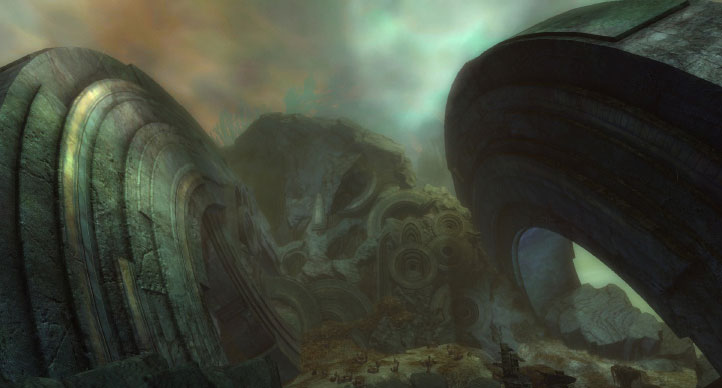
 In light of this issue focusing on the lives of game developers and the changes taking shape in the industry over the years, we’ve managed to steal a few moments from the ever busy Colin Johanson, Game Director for Guild Wars 2.
In light of this issue focusing on the lives of game developers and the changes taking shape in the industry over the years, we’ve managed to steal a few moments from the ever busy Colin Johanson, Game Director for Guild Wars 2.
Colin’s game producing career has most recently been spent at ArenaNet, but his involvement in gaming goes well beyond his 9 years spent on the Guild Wars team. His career dates back to 1997, when he worked as a game designer on Dragon’s Gate, and later as lead designer on the Multi-User Dungeon (MUD) created by Mark Jacobs’ Interworld Productions (the company that would later become Mythic Entertainment). Additionally, he spent time working for Zipper Interactive and Games Workshop.
Thank you Colin for taking the time to meet with me today. A lot of our members are excited to hear what you have to say about the future of Guild Wars 2 as well as gaming in general.
Let me start of by asking, what was it like working with Mark Jacobs on Dragon’s Gate? This was the starting point of the revolution that would become MMORPG’s and quite possibly one of the game changing titles that opened the door for games like Dark Age of Camelot. What was it like to witness these early days of online multiplayer games?
Colin Johanson (CJ): When I first started working for Interworld Productions, Mark was focused on a number of other products at the time separate from Dragon’s Gate, predominantly Spellbinder (Magestorm 2) and Darkness Falls, so I didn’t really work with him very much. My time was mostly spent learning from Darrin and Lori Hyrrup, two of the original pioneers in the game industry who later helped create Dark Age of Camelot (DAoC) and made it the amazing hit that it became. They really helped set my career in motion, in particular seeing potential in me and trusting a teenager to take over as lead designer on a team and a project with GMs with decades more life experience to offer; if not for them taking that chance on me, I’m not sure where I’d be today.
Since you asked about him in particular, one fun Mark story I can share is when I spent a summer out in Virginia during college (I mostly worked remotely during those years) cleaning up code Mark wrote in the very early days of Dragon’s Gate. For all I know, it’s the only code he ever wrote, but I can say based on that experience he was a far better CEO than he was a coder!
The big three online text-based RPG games back when AOL was huge and “published” everyone on the MUD side were really Gemstone, Dragon’s Gate, and Dragon Realms. Those three in particular, with countless hundreds of other text-based games and limited graphical MMO’s like Magestorm, helped set the foundation for where MMOs would go in the future. The lessons learned from Dragon’s Gate and Darkness Falls provided a lot of the inspiration and concepts that led to the creation of DAoC. For example, I’m not sure how many people realize that “Darkness Falls,” the iconic location in DAoC, was named after one of Mythic’s big online text-based games back in the day.
One of the great ironies (and inspirations) to me is how graphics-based MMO’s have spent the last two decades trying to get back to the things that made those early text-based games such amazing experiences. Those early text games were living worlds; there were live scenarios and storylines constantly running in the game being led by the designers (GMs) that literally changed, created, and destroyed parts of the world. There were live player-run scenarios and storylines, political intrigue between the players, player-run stores, player-created economies, and even player-created parts of the world. Some MMOs have done some really great stuff over the years, but it’s nearly impossible to capture the freedom of change within the game that text as a medium gave the players/developers to work with.
I don’t think any of us could have imagined just how big the MMORPG scene would become in just the short few years it’s been around. I imagine if anyone had that vision it would have been someone on the front lines. Did you expect to see the rise of MMORPG’s to be so rapid?
CJ: I feel like that jump wasn’t that hard to predict, it was just the future of where gaming was going as the Internet became more approachable and - maybe even just as important - affordable. Suddenly, games that traditionally had been reserved as single-player experiences were all going to open up to the world of multiplayer. When thinking about those early single-player RPGs like Quest for Glory, or King’s Quest, or Final Fantasy, there was always one big barrier: I couldn’t have my friends over (or go someplace) and play the game with them. I had to make the choice: hang with my friends, which meant Mario Kart, GoldenEye, Street Fighter, etc., OR go solo and play an RPG. That choice naturally put limitations on those games and prevented them from a broader appeal or shared experiences. Once that wall was down, a new genre would almost inevitably grow out of that.
Two MMOs stand out to me as the ones I look back on that I’m not sure I ever thought would reach the levels of success they have: Lineage and World of Warcraft. For western gamers, the first name really likely doesn’t mean very much, but Lineage was the east’s version of WoW before WoW ever existed when considering massive, breakout, industry-defining success. UO, EQ, and DAoC were huge success stories for their time, but Lineage and WoW just crushed them in both revenue and players. The jump from what was considered a “successful” MMO when comparing WoW or Lineage to the other games of their generation was just incredible. To this day, most new MMOs are generally lucky to come in around the same ballpark userwise of where EQ/DAoC were back in the day, and I’d guess most of them would consider that a success.
Free-to-play has been another really interesting addition to the mix, and something I’d have never considered an option 15+ years ago when I thought about where the industry would go Bandwidth costs dictated monthly (or hourly!) fees as a mandatory part of the experience. The games recently that can claim the kind of player numbers in the ballpark of a WoW or Lineage are almost all F2P titles, and in the east some of the F2P titles number users in the 30-50 million range, absolutely destroying any kind of conceivable active user numbers I could have ever imagined. It’s worth noting, though, that only a very small percentage of users in most F2P games actually generate revenue, so it’s not exactly a straight comparison when talking vs. WoW/Lineage, but it’s still very impressive.
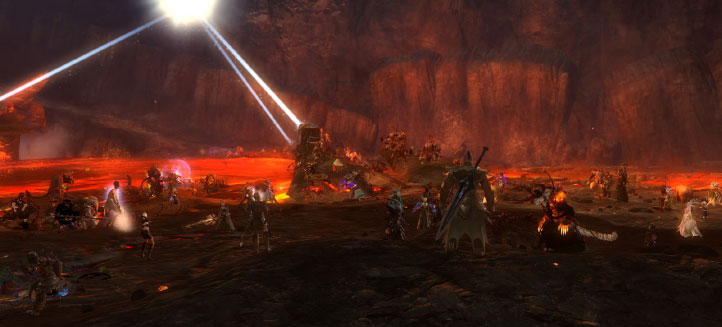
I imagine that in the early days there was a lot of criticism and disbelief that Massively Online Multiplayer games would be successful. Did you find people downplaying your achievements early on? Any funny experiences to share?
CJ: I remember back in the day that folks playing MUDs used to make fun of the early graphical MMOs because they didn’t have the flexibility to change the world and players couldn’t drive the stories and role-playing the way text games allowed. The latency was so terrible in the early graphical experiences that oftentimes games could be borderline unplayable. You have to remember, everyone was on dial-up. I’ll never forget that sweet, sweet modem sound when you dialed in to play. A lot of folks thought they’d each be a flash in the pan and gone again because of how you could literally do anything in the world in text-based games, but graphics limited your “sandbox” dramatically. I remember specifically reading forum threads about how EQ sucked cause you couldn’t “RP any way you want” like you could in a text-based RPG.
EQ, UO, DAoC, and others proved that wrong and opened up the genre to a much larger audience. Suddenly, MMOs were seeing a million subscribers, and they were paying $10–15 a month, which to a lot of folks may have seemed expensive at the time—little did they know the very first MMOs used to be far more expensive. In the earliest days of text-based MMOs on GEnie, you’d pay upwards of $12/hr to play many of the games! Even during AOL’s prime years, games like Dragon’s Gate were $2/hr to play. Bandwidth costs sure have changed over time!
In 2005 you joined ArenaNet, what was the studio like back then? Do you find the lifestyle is similar to the way it was or has it evolved over time?
CJ: Well, first and foremost, it was much smaller. You knew everyone, you saw everyone every day, and it was a very small, tight-knit family. Everyone had to work on everything, it felt like, to be able to get parts of the game done. Each individual team/department on GW2 now is a bit like what the entire ArenaNet company was back in those days on GW1, Prophecies in particular. Some things haven’t changed from those early days - this company has always tried to do big, ambitious, push-the-limit ideas, and I think that spirit lives on to this day at the core of what ArenaNet is.
One fun story to help give an idea of what that ship process for Prophecies was like: I was hired about five weeks before Prophecies shipped, and at the time, there were almost no quests other than the main story “link quests” to support the missions in the game. There was a big Word doc I was handed on my first day filled with quests Eric had written, and Ben asked me to “build as many as you can.” There was a crazy haze of caffeine and sleeping on the floor while waiting for my stuff to arrive from Virginia in a moving van, and five weeks later, Prophecies went out the door. Everyone from that release has their own amazing story about that ship experience; it was a hell of a bonding moment for the entire company. It’s amazing how welcoming that team was to someone who showed up for the very end. It felt like family after just a few days; I’ll never forget that. Sometimes I think back on it and can’t believe it all turned out as well as it did. That’s just the company culture of ArenaNet: everyone was insanely talented and pulled off miracles every day.
One of my favorite memories that helps give an idea of the early culture of ArenaNet is the very first Halloween festival in Guild Wars. I remember a company e-mail went out asking if people wanted to volunteer to work some extra hours to build something small to celebrate Halloween for the players. I went to the meeting room on a Friday afternoon expecting a few people to be there, and instead it was like half the company - everyone wanted to pitch in. We basically worked the entire weekend and knocked out the Halloween festival, Mad King Thorn jokes and all, and it was awesome. That’s how live events got made in the early days in Guild Wars, and it set the stage for so much of what would follow.
The company/culture has evolved a lot over time, predominantly as a result of going from around 60 or 70 employees to over 350. It’s unavoidable when a company changes that much in a relatively rapid period of time, but with great change comes great opportunity. Guild Wars was a great success for us, but the team we had back then was far too small to be able to take on a daunting and massive project like GW2. Also, our office is no longer in danger of falling over into a swamp, which is a nice bonus.
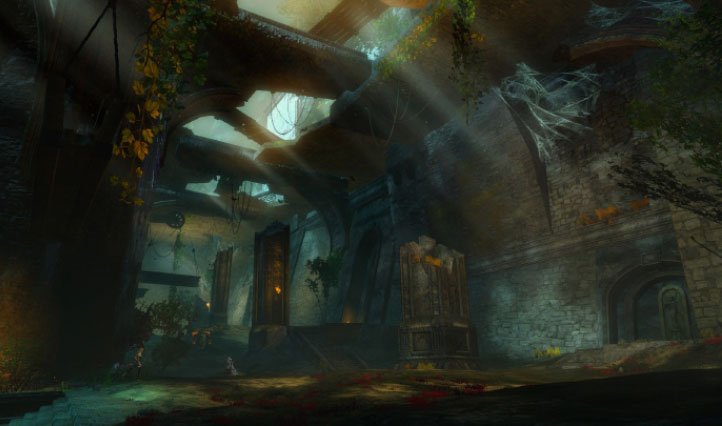
Between the work that you did on the original Guild Wars and Guild Wars 2 what has been one of the greatest obstacles that you and the team have had to overcome?
CJ: There have been so many obstacles over the years… I think one of my favorites was trying to find out if the dynamic event system was going to be successful. The GW2 engine was a multi-year project before we could start using it as designers, which meant we needed some place to test our crazy ideas about this “event” system that’d later define so much of the content in GW2. The idea was floated that we should just build the event system in GW1, and so Queensdale was born! What feels like ages ago, we started out by building the garrison, and the centaurs, and the human starting area using the GW1 engine and built a fake event system to learn what GW2 would be like.
Those lessons provided the guidance and outline we used to craft the dynamic event system in GW2 and helped us answer the question that, yes indeed, events would be a viable model for us in our new game. Figuring out how every little component would work - scaling, removing player conflict, handling rewards, messaging, content direction, pacing of content, etc. - all came after that, and each proved to be their own obstacle to overcome, but that very initial concept helped us solve the biggest question of all: should we do it?
Guild Wars 2 has changed focus and shape constantly since it’s launch. As you refine this product more, what areas do you see the most consistent demand and growth?
CJ: We have a very demanding customer base. They expect consistent growth and support not just in a few specific areas, but in every area of the game! We love that; we want to be pushed to be the best possible developers we can be. Our players are our partners on this wild ride that is an MMO, and the high bar they expect from us is a huge compliment to the potential they see in our game. With a game as large as GW2, it’s a challenge to try and keep up with all the different components of the game, to update and focus on and attempt to strike a balance between them, but we’ll continue to do our best to meet our fans’ insatiable appetites for more! I really can’t pick even a few specific areas; we want to ensure we’re making the entire game better and helping it all consistently grow.
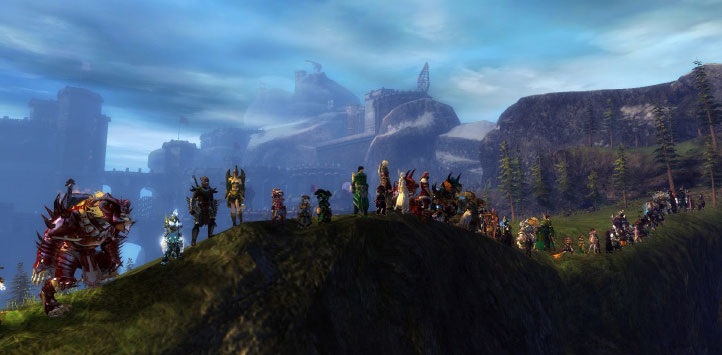
The April 2014 patch was quite possibly one of the largest upgrades to hit Guild Wars 2 so far, are there plans for more patches like this in the future?
CJ: There will absolutely, positively be more feature packs in the future for Guild Wars 2. Our first feature pack was extremely successful for us, and we’re looking forward to doing more!
In your time both creating and playing Guild Wars 1 & 2, what has been the one thing that stands out for you when you think about your favorite memory? Is there something that you are most proud of?
CJ: Wow, that’s a tough one. I think my favorite memory from GW1 was getting to work on and help drive many of the festival, minigame, and fun side quest projects. From roller beetle racing, Kilroy boxing, polymock, secret snowman lair, Halloween, Wintersday, lunar festival, parts of Sorrow’s Furnace, the bonus mission pack, and more, I got a chance to work on some amazingly fun projects with a lot of incredibly talented people. I didn’t get to build a lot of the content in GW2 - being more on the management team for the project - other than some of the very early events in Queensdale, so I have a lot of fond memories of those days from GW1 when I came in every day and got to build the world. Being game director is also an awesome dream job, but it’s rewarding in different ways than building content was.
On GW2, five years of development before release gives a lot of time for great memories, but my favorite is absolutely the first time we brought the playable demo of the game to Gamescom in Germany. We’d spent three months before that working like crazy to polish and clean up every little detail we could to get ready for that world premiere, and in the matter of those three months, the game massively transformed from a prototype we saw potential in to a fully functional and playable game with two complete maps. We all felt pretty confident about where the game stood, but when you’re as close to the project as we all were, it sometimes can be hard to tell how something will be received when rolled out to a large audience - in particular an audience as massive as Gamescom.
I remember being so nervous, amped, and excited that I barely slept on the flight to Germany or the first few days we were there before the show began. I remember Eric and I staying up way too late talking about game design ideas due to all the adrenaline and nerves from knowing what was coming. A day before the show, a press outlet shot some really grainy footage of one of our practice presentation settings on the show floor and released it as “world’s first” footage of GW2. It was grainy, our characters were all using dev commands to be invisible so the mobs didn’t actually react to us, and it was a horrible way to see the game for the first time. The Internet exploded with people talking about how bad the game looked - combat with mobs that ignored players and such. A day before the actual show, here we were with some horrible first footage as the first thing anyone saw of our demo, and let’s just say…that’s not exactly the way we’d hoped to show GW2 to the world - via fake, temporary, test-run demo.
Another mostly sleepless night later and the show began. We had lines 4 - 6 hours long on the show floor and 9 hours straight of back-to-back-to - well, you get it - media sessions up in the press center. Back in Seattle, the entire rest of the company stayed up all night every night playing in the maps with all the people on the show floor to help show the true MMO experience when you played in a map filled with other players. They worked in shifts, had a command HQ that helped coordinate groups of devs to join events other players were doing to show how dynamic scaling worked, and generally tried to make it a giant 4-day (overnight) party at the office.
By the end of day one, we were all dead tired, both in Seattle and Germany, and the show had barely begun…but most importantly, the reaction was overwhelmingly positive. Maybe more positive than we even thought was possible. People absolutely loved it; they got back in line multiple times to wait 4 - 6 hours to play again. The reviews and comments coming out of the show were glowing, and the vibe around the game suddenly shot through the roof overnight.
When we all returned home, we did it all again at PAX and showed the game one more time to the same fan reaction in the US, and it reinforced to all of us just how big GW2 could be. The feeling on the team shifted after those shows. I remember a distinct transition from all of us thinking it could be good to knowing it was going to be good after that. It was a validation of years of work and a deep sigh of relief for all of us at ArenaNet, and it really changed the dialogue around the game from that day forward. I’ll remember that feeling on the flight home from Gamescom for the rest of my life, and as a bonus, I could finally sleep knowing everything was going to be OK.
What else can you tell us about the future of Guild Wars 2 and the goals you are striving to achieve over the next few months to a year?
CJ: I can tell you we’re extremely excited about Guild Wars 2 in 2014, and we hope all our players are equally excited once we’re able to announce all our plans! Also, they absolutely won’t want to miss Living World Season 2 starting on July 1st. More info…when it’s ready!
Since you first started working with Multiplayer RPG’s you’ve seen them go from text based to virtual reality. Where do you think it will be in another 10 years? With Oculus Rift and many other VR technologies hitting the shelves and VR making an appearance. What challenges do you foresee as developers to maintain an edge on this ever changing technology.
CJ: I was talking with a friend at PAX East in Boston not long ago about this, and I think the VR side is going to be really interesting - in particular for games where the monitor/TV can’t do a great job of very quickly allowing you to assess the situation around you with camera movements. For example, flight sims or driving sims where you can quickly look above/around you with the VR options will be amazing and make a massive leap in a genre that’s made precious few steps in the last decade. Maybe if someone brings back X-Wing vs. Tie Fighter (DO THIS PLEASE!) it could be amazing without having to contend with some of the clunky camera interactions and getting a true fighter pilot experience. I don’t see all games going this route, but I certainly see some types where the VR side could certainly bring a lot to their experience.
As for the genre as a whole, I think we’ll continue to see more work towards making MMOs feel like you’re truly living inside of a living game world - be that through VR, truly dynamic AI capable of making decisions that define and change the world, the next evolution of event content systems, real-time multiplayer stories that affect the world, or fully player-owned/run worlds. We’re going to see more power being put in the players’ hands in their ability to change, define, and own their world - and a world which in turn reacts to those actions and interactions the players make. Ironically, in many ways it takes us all the way back to your very first question. Games are more and more going back to what they were long ago, when they were text based - easy to modify worlds that users can impact, change, and even own. But they’re doing it to a level of modification, change, and world reaction I’m not sure even the text-based gamers could have imagined possible. And they certainly wouldn’t have thought it possible in a graphics-based online RPG.
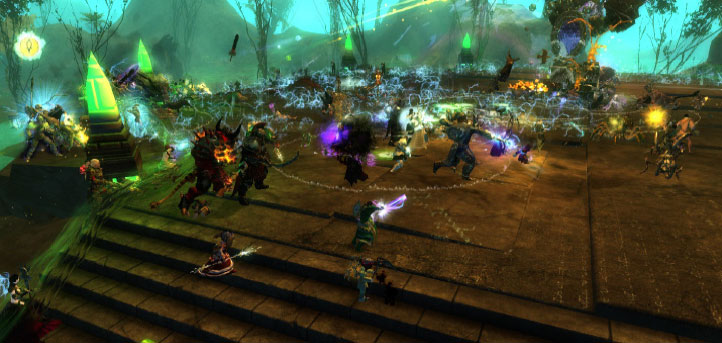
About the Author

Foghladha
Managing Editor
Foghladha founded the Gaiscioch Social Gaming Community in 2001 and has since been the founder & activities director for this well known community. His role has gone beyond just running the Gaming Community and now includes running the Athletics Program in Portland, Oregon, as well as acting as the Managing Editor of the Gaiscioch Magazine, and is the Lead Producer on the Gaiscioch Livestream Productions. Additionally he networks with game developers to form relationships between Gaiscioch and development studios.
His experience in publishing dates back to helping his Grandparents who operated a printing press for over 40 years. In high school and college Benjamin excelled in journalism and played an active part in the school newspaper. Foghladha currently works full time as the director of technology for a franchise trade publication & education company.
